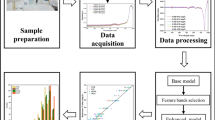Abstract
A method of detecting chemical oxygen demand (COD) of water based on ultraviolet (UV) absorption spectra is proposed. The modeling and analysis of the standard samples and the actual water samples are carried out respectively. For the standard solution samples, the univariate linear models based on single wavelengths and the partial least square (PLS) model based on synergy interval partial least square (SiPLS) and moving window partial least square (MWPLS) are established. For the actual water samples, different pre-processing methods are used. SiPLS and MWPLS are used to select the characteristic bands. The least squares support vector machine algorithm optimized by particle swarm optimization (PSO-LSSVM) algorithm is used to establish the prediction model, and the prediction results of various models are compared. The results show that the optimal model is PSO-LSSVM which uses SiPLS to select the characteristic bands of the first derivative spectra (preprocessing method). The determination coefficient of the prediction set is 0.963 1, and the root mean square error of prediction (RMSEP) is 2.225 4 mg/L. PSO-LSSVM algorithm has good prediction performance for the analysis of COD in actual water samples by UV spectra. This paper provides a new design idea for the research and development of water quality detection optical sensor.
Similar content being viewed by others
References
MENDES E, DUARTE N. Mid infrared spectroscopy as a va1uab1e too1 to tack1e food ana1ysis a 1iterature review on coffee dairies honey o1ive oi1 and wine[J]. Foods, 2021, 10(2): 477.
JAN U P, DIETMAR R K, REINHOLD C. On-line application of near infrared (NIR) spectroscopy in food production[J]. Trends in food science and technology, 2015, 46(2): 211–230.
KUMAR A, JAIN S K. Development and validation of UV-spectroscopy based stability indicating method for the determination of fluoxetine hydrochloride[J]. Analytical chemistry letters, 2016, 6(6): 894–902.
YUAN J Z, LU Q P, WU C Y, et al. Noninvasive human triglyceride detecting with near-infrared spectroscopy[J]. Spectroscopy and spectral analysis, 2018, 38(1): 42–48.
MASSIE C, KNAPP E, CHEN K, et al. Improved prediction of femoral fracture toughness in mice by combining standard medical imaging with Raman spectroscopy[J]. Journal of biomechanics, 2021, 116(2): 110243.
FERREIRO G M, AYUSO J, ÁLVAREZ J A, et al. Gasoline analysis by headspace mass spectrometry and near infrared spectroscopy[J]. Fuel, 2015, 153: 402–407.
ZHOU K P, BAI X F, BI W H. Detection of chemical oxygen demand (COD) of water quality based on fluorescence multi-spectral fusion[J]. Spectroscopy and spectral analysis, 2019, 39(3): 813–817.
ZHOU K P, BI W H, ZHANG Q H, et al. Influence of temperature and turbidity on water COD detection by UV absorption spectroscopy[J]. Optoelectronics letters, 2016, 12(6): 461–464.
DAHLBACKA J, NYSTROM J, MOSSING T, et al. On-line measurement of the chemical oxygen demand in waste water in a pulp and paper mill using near infrared spectroscopy[J]. Open journal of statistics, 2014, 2(4): 19–25.
WU G Q, ZHAO W. Seawater chemical oxygen demand optical detection method based on Raman spectroscopy[J]. Journal of applied optics, 2019, 40(2): 278–283.
HARRINGMEYER J P, KAISER K, THOMPSON D R, et al. Detection and sourcing of CDOM in urban coastal waters with UV-visible imaging spectroscopy[J]. Frontiers in environmental science, 2021, 9: 647966.
WU G Q, BI W H. Research on chemical oxygen demand optical detection method based on the combination of multi-source spectral characteristics[J]. Spectroscopy and spectral analysis, 2014, 34(11): 3071–3074.
Author information
Authors and Affiliations
Corresponding authors
Additional information
Statements and Declarations
The authors declare that there are no conflicts of interest related to this article.
This work has been supported by the National Natural Science Foundation of China (No.61963031), the Inner Mongolia Autonomous Region Natural Science Foundation (No.2019MS06017), and the Scientific Research Projects of Colleges and Universities in Inner Mongolia Autonomous Region of China (No.NJZY20122).
Rights and permissions
About this article
Cite this article
Zhou, K., Liu, Z., Cong, M. et al. Detection of chemical oxygen demand in water based on UV absorption spectroscopy and PSO-LSSVM algorithm. Optoelectron. Lett. 18, 0251–0256 (2022). https://doi.org/10.1007/s11801-022-1143-5
Received:
Revised:
Published:
Issue Date:
DOI: https://doi.org/10.1007/s11801-022-1143-5



